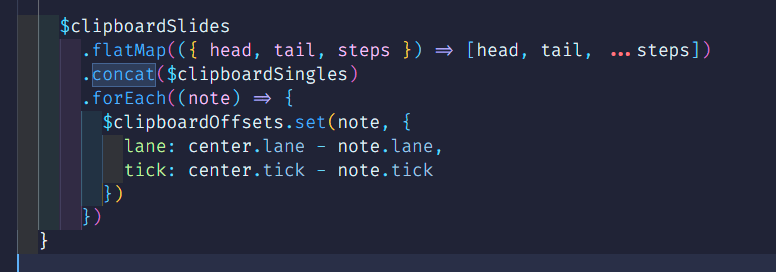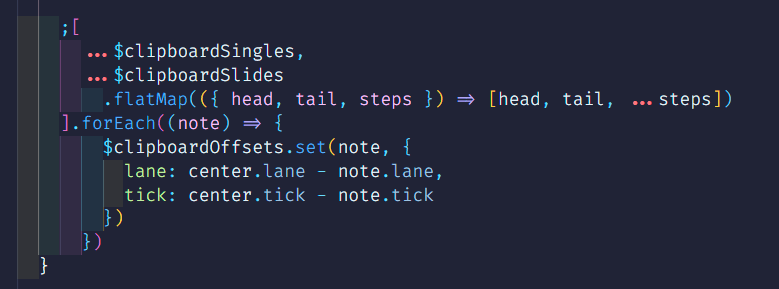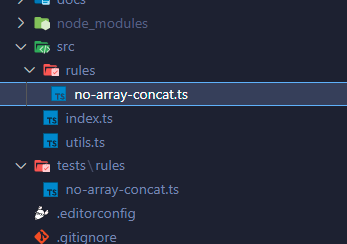나만의 ESLint 규칙을 만들어보았다.
PaletteWorks Editor 개발중에 어떤 버그가 있어 수정하려 코드를 자세히는 아니어도 대강 5번 정도 읽었지만 찾지못한 concat()이라는 사악한 녀석이 있습니다.

따로 염두하며 보며 괜찮었겠지만, 염두하지않고 보면 전혀 눈치채지 못하죠.
아마 filter, map, forEach의 일종이라 뇌가 분류한 것일까요.
어차피 [...a, ...b] 문법도 있어서, 이걸 사용하면 쉽게 알 수 있었을텐데 실제 개발도중에 딱히 염두하지 않다가, 저것으로 리팩토링한 적도 있습니다.

리팩토링하면 이렇게 되는데 꽤 읽기 편해졌다 생각합니다.
목표
그래서, 실제로 ESlint를 만들어 concat를 소멸하려합니다.
TL;DR
레포지토리입니다. (Initial Commit에 코딩이 집중되어 있는건, 이것저것 건들여보아도 잘 돌아가지 않다가, 성공했을 때 commit 했기 때문입니다.)
사전 지식
ESLint란?
JavaScript 검증도구입니다. 가끔 잘 못 적어도, 컴파일러가 별 말 없을 때도 있고, 컴파일하기 전에 (코드를 치면서) 눈치채고 싶으므로, 컴파일러와 다르게 코드의 정확성을 검증하기 위한 도구로 이용됩니다.
보통 컴파일러의 에러, 문법 에러보다 세세한 부분을 엄격하게 하는 경우가 많은데, ESLint는 그것을 커스터마이즈할 수 있어 편리하죠.
AST
추상 구문 트리(abstract syntax tree)를 의미하며, 컴파일러나 파서가 사람이 적은 코드를 읽을 때 쓸모없는 것을 제거해, 문법만 읽을 수 있게 하는 것으로, ESLint가 파서에 의해 만들어진 AST를 근간으로 코드를 검증합니다.
실제 TypeScript, Babel 같은 트랜스파일러도 AST 생성하고 있습니다.
ToDo
필요한 것
- eslint 플러그인 표준
- npm 출시할 준비
하면 좋을 것
- TypeScript로 적어서 빌드 후에 출시
- Jest로 테스트
- 그 외 등등
인프라
우선 TypeScript + Jest 같은 인프라를 준비합시다.
pnpm i -D typescript @types/node
pnpm i -D jest @types/jest ts-jest
pnpm i -D npm-run-all rimraf np
(np 개발이 정체되어있고, 왜인지 최근 잘 안 돌아가는 것 같아서 release-it, publish-please, semantic-release 같은 것으로 할까 생각했지만 np를 다른 부분으로 바꾼 것 뿐이므로 그대로 하겠습니다.)
// package.json
{
"name": "eslint-plugin-no-array-concat",
"version": "0.0.0",
"description": "ESLint rule for not using Array.prototype.concat()",
"scripts": {
"clean": "rimraf dist",
"build:typescript": "tsc",
"build": "run-s clean build:typescript",
"test": "jest",
"publish": "np",
"release": "run-s clean build test publish"
}
}
// tsconfig.json
{
"compilerOptions": {
"target": "ES2015",
"module": "CommonJS",
"rootDir": "./src",
"outDir": "./dist",
"types": ["node"],
"typeRoots": ["./"]
},
"include": ["src", "global.d.ts"],
"exclude": ["node_modules", "tests"]
}
// tsconfig.test.json
{
"extends": "./tsconfig.json",
"compilerOptions": {
"noEmit": true
},
"files": ["estree.ts"],
"include": ["tests/**/*.ts", "global.d.ts"]
}
// jest.config.js
module.exports = {
preset: 'ts-jest',
testMatch: ['**/tests/**/*.ts'],
globals: {
'ts-jest': {
tsconfig: './tsconfig.test.json',
},
},
};
# 폴더구조
node_modules/
dist/

문서를 쓴다
우선 간단하게 문서를 적어둡시다. docs/rules/no-array-concat.md
간단한 동기, 목적, 검증되는 것과 검증되지 않는 것, 사용하지 않을 때, 리소스, 링크 등등 공식 문서 구성을 참조하면 좋을 것이라 생각합니다.
이것으로 알게된 것은 해야할 것이 Array 인스턴스가 concat를 호출할 때만 에러를 뿜으면 된다는 것입니다.
문제 발생
하지만 여기서 문제가 발생했습니다. Array 인스턴스, 혹은 Array 타입은 그 안에
- Array 리터럴
[1, 2, 3] - Array 변수
let a = [1, 2, 3]; a - Array를 반환하는 것
[1, 2, 3].map((x)=>x+1)
이런 것들이 있습니다.
1번은 금방 Array라는 걸 알 수 있으니까 괜찮고, 3번도 어느정도는 괜찮은데 2번은 약간 거시기합니다. 그렇게하면 Array 이외의 다른 것과 concat을 구별하지 못하기 때문입니다. 게다가 예를 들어 Buffer 같은 concat 외에는 선택지가 없는 것도 있고, Array가 아닌 곳에서 concat를 사용하는 클래스 메서드도 있습니다.
ESLint에는 변수에 타입을 판정하는 기능이 있지 않아서 공식에서 만든 array-callback-return에서도 단순하게 이름이 map, filter, some인 것을 이용해서 Array가 아닌 것에도 영향을 끼칩니다. 이 규칙이 권장되지 않는 이유 중 하나인 것 같습니다.
어쩌죠.....
해결
JavaScript와 타입이라하면 TypeScript! TypeScript에는 타입 정보가 있습니다. 이를 이용하면 위에 언급한 것이 해결될 것 같지 않습니까?
그러니 TypeScript 관련된 것은 어떻게 lint될까요. 실은 TypeScript ESLint이라 하는 상당한 물건이 있습니다. 실제 TypeScript 코드도 이걸 쓰면 간단하게 검증할 수 있습니다.
ESLint에는 플러그인(규칙, 설정, 특수파일 처리)외에도파서를 지정할 수 있습니다. TypeScript ESLint에는 TypeScript(.ts) 파일을 해석하므로 플러그인 @typescript-eslint/eslint-plugin, 파서 @typescript-eslint/parser 둘 다 지정할 수 있습니다.
여기에 더 굉장한 것은 @typescript-eslint/parser은 TypeScript가 아니라 JavaScript도 검증할 수 있으므로 @typescript-eslint/parser를 근간으로 만든 플러그인은 소소한 설정(.tsconfig / .eslintrc)만으로 JavaScript 프로젝트를 lint 할 수 있습니다.

실제로 만들어보자
설치
pnpm i -D @typescript-eslint/parser
pnpm install @typescript-eslint/utils eslint-ast-utils
준비

위와 같이 구성이 되도록 파일을 만들거나 헬퍼 모듈을 적읍시다.
// src/utils.ts
import * as path from 'path';
import { ESLintUtils } from '@typescript-eslint/utils';
export const createRule = ESLintUtils.RuleCreator((name) => {
const dirname = path.relative(__dirname, path.dirname(name));
const basename = path.basename(name, path.extname(name));
return `https://github.com/mkpoli/eslint-plugin-no-array-concat/blob/master/docs/${dirname}/${basename}.md`;
});
// src/index.ts
module.exports = {
rules: {
'no-array-concat': require('./rules/no-array-concat'),
},
};
테스트케이스 만들기
https://typescript-eslint.io/docs/development/custom-rules/#testing-typed-rules
타입검사기능을 사용할 때는 테스트를 할 때 .tsconfig.json가 필요하므로, 이를 위한 RuleTester를 준비합시다. 내용은 아무래도 좋지만 file, estree.ts 포함하지 않으면 에러가 나옵니다.
// tests/rule/no-array-concat.ts
import rule from '../../src/rules/no-array-concat';
import { TSESLint } from '@typescript-eslint/utils';
export const ruleTester = new TSESLint.RuleTester({
parser: require.resolve('@typescript-eslint/parser'),
parserOptions: {
ecmaVersion: 'latest',
sourceType: 'module',
project: './tsconfig.test.json',
},
});
ruleTester.run('no-array-concat', rule, {
valid: [
{
code: '[...a, ...b]',
parserOptions: { ecmaVersion: 6 },
},
'Array.concat()',
{
code: 'foo.concat(bar)',
},
'new CustomClass().concat()',
],
invalid: [
{
code: '[1, 2, 3].concat([4, 5, 6])',
errors: [{ messageId: 'noArrayConcat' }],
},
{
code: 'var foo = [1, 2, 3]; foo.concat([4, 5, 6])',
errors: [{ messageId: 'noArrayConcat' }],
},
{
code: 'var foo = new Array(3); foo.concat([4, 5, 6])',
errors: [{ messageId: 'noArrayConcat' }],
},
{
code: 'var foo = [0, 1, 2].map(x => x + 1); foo.concat([4, 5, 6])',
errors: [{ messageId: 'noArrayConcat' }],
},
],
});
규칙을 만들자
이제는 규칙을 만들어봅시다.
// no-array-concat.ts
import { AST_NODE_TYPES, TSESTree } from '@typescript-eslint/utils';
import { ESLintUtils } from '@typescript-eslint/utils';
import { getPropertyName } from 'eslint-ast-utils';
import { createRule } from '../utils';
export = createRule({
name: __filename,
meta: {
type: 'suggestion',
docs: {
description:
'Prevent using Array.prototype.concat() for Array concatenation',
recommended: false,
},
schema: [], // Add a schema if the rule has options
fixable: 'code',
messages: {
noArrayConcat: 'Do not use Array.prototype.concat(...)',
},
},
defaultOptions: [],
create(context) {
const parserServices = ESLintUtils.getParserServices(context);
const checker = parserServices?.program?.getTypeChecker() as any;
if (!checker || !parserServices) {
throw Error(
'Types not available, maybe you need set the parser to @typescript-eslint/parser'
);
}
function disallowedConcat(node: TSESTree.CallExpression) {
if (node.callee.type !== AST_NODE_TYPES.MemberExpression) {
return;
}
const callee = node.callee as TSESTree.MemberExpression;
const propertyName = getPropertyName(callee);
if (!propertyName || propertyName !== 'concat') {
return;
}
const tsNodeMap = parserServices.esTreeNodeToTSNodeMap.get(
node.callee.object
);
const type = checker!.getTypeAtLocation(tsNodeMap);
if (!checker.isArrayType(type)) {
return;
}
context.report({
messageId: 'noArrayConcat',
loc: callee.property.loc,
node,
});
}
return {
CallExpression: disallowedConcat,
};
},
});
create(context) 함수
파라메터 설정은 생략하겠습니다.
create 함수는 검증 로직을 적는 곳입니다.
const parserServices = ESLintUtils.getParserServices(context);
const checker = parserServices?.program?.getTypeChecker() as any;
가장 위에 것은 @typescript-eslint/parser의 마법으로 이걸 사용하면 TypeScript 내부의 타입검사기능을 얻을 수 있습니다. 이제부터는 타입체크 할 수 있습니다.
그리고 create 반환값에 주목해주시면 CallExpression:은 AST 안에 모든 CallExpression, 모든 함수가 호출 된 트리 노드에 이 처리를 합니다.
여기에 disallowedConcat 콜백 함수를 줍시다.
이 함수에는 첫 번째 인수가 note인데 CallExpression 노드 인스턴스입니다.
callee 판단
CallExpression은 주로 callee, parameter 2가지로 인해 결정됩니다. parameter 설명은 딱히 필요없겠지만, callee를 설명하면 parameter 이외의 전부입니다. 한마디로 호출된 함수거나 사전 정보입니다.
if (node.callee.type !== AST_NODE_TYPES.MemberExpression) {
return;
}
const callee = node.callee as TSESTree.MemberExpression;
MemberExpression는 오브젝트 프로퍼티에 접속하는 녀석으로 ., []으로 표현되는 관계입니다.
foo.bar, foo[bar] 같이요
제 목표가 foo.concat(bar)를 제어하는 것이므로 CallExpression callee가 MemberExpression foo.concat가 되지 않으면 됩니다. 그 외에는 에러를 뿜을 필요가 없으므로 그대로 리턴합니다.
callee.property 판정
MemberExpression도 같은 형식으로 foo.bar가 object인 foo와 property인 bar로 구성됩니다.
이것을 자세히 보면
const propertyName = getPropertyName(callee);
if (!propertyName || propertyName !== 'concat') {
return;
}
property 명이 "concat"일 필요가 있으므로 eslint-ast-util에 있는 편리함 함수를 사용해 판정했습니다.
callee.object 판정
const tsNodeMap = parserServices.esTreeNodeToTSNodeMap.get(node.callee.object)
const type = checker!.getTypeAtLocation(tsNodeMap)
if (!checker.isArrayType(type)) {
return;
}
object가 Array일 필요가 있습니다. 좋았던 것은 TypeScript 컴파일러 타입체커에는 isArrayType 메서드입니다.
하지만 그걸 export하지 못하므로 직접 사용할 수 없습니다. 어떻게할까 생각하다가 예전에 만든 global.d.ts에 묻혀있던 isArrayType를 꺼내가지고 왔습니다.
다음에는 eslint-ast-utils에도 타입이 정의되어 있지 않으므로 미리 붙여줍시다.
// global.d.ts
declare module 'eslint-ast-utils' {
export function getPropertyName(
node: TSESTree.MemberExpression
): string | undefined;
}
declare module 'typescript' {
interface TypeChecker {
// internal TS APIs
/**
* @returns `true` if the given type is an array type:
* - `Array<foo>`
* - `ReadonlyArray<foo>`
* - `foo[]`
* - `readonly foo[]`
*/
isArrayType(type: Type): type is TypeReference;
/**
* @returns `true` if the given type is a tuple type:
* - `[foo]`
* - `readonly [foo]`
*/
isTupleType(type: Type): type is TupleTypeReference;
}
}
이제 에러없이 사용할 수 있습니다.
ESLint에 알리기
모든 예외 상황을 하나씩 제거한 후에, 담은 것은 진짜 Array.prototype.concat이 사용되는 상황 밖에 없습니다(만일 그것이 다르게 쓰여져도).
context.report({
messageId: 'noArrayConcat',
loc: callee.property.loc,
node,
});
context.report로 알리면 정상적으로 에러가 나옵니다.
테스트하기
정상적으로 작동하는게 테스트해보죠
pnpm run test
빌드하고 완성
pnpm run build
npm에 올리기
pnpm run release
끝
결론
여기까지 딱 10시간정도 걸렸습니다. 아직 미숙해서 엄청 조사하고 엄청 시도해보다보니 완성했습니다. 와~! 완성!
이걸로 쾌적한 lint 생활을 시작할 수 있습니다. 여러분도 자주 착각할 수 있는 곳에 부디 자신만의 lint를 만들어보는건 어떨까요?
역자후기
배열에서 사용하는 concat를 대상으로 한 lint를 만들고 싶어서 타입을 확인할 수 있는 typescript를 사용했다 했는데, Array.isArray로 판정해서 배열이면 거기서 concat를 사용할 시 에러가 나오게끔 하면 안 되는 것인가 궁금하다...